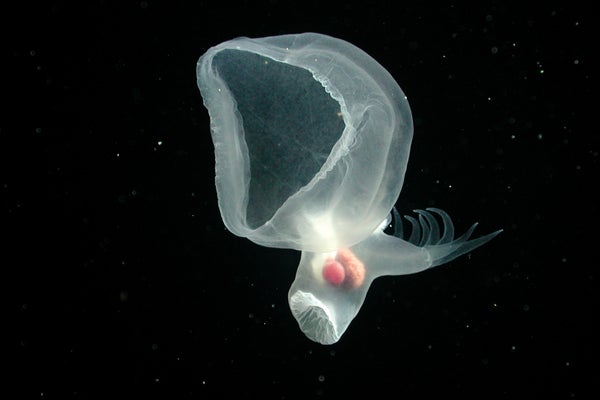Glowing Mystery Mollusk Finally Identified
January 23, 20252 min readGlowing Mystery Mollusk Finally IdentifiedThis strange sea creature stumped scientists for 20 years. Heres what it really is.By Jude Coleman edited by Sarah Lewin FrasierA mystery mollusk observed by MBARIs remotely operated vehicle Tiburon in the outer Monterey Canyon at a depth of approximately 1,900 meters 2021 MBARIAbsolute darkness. Crushing pressure. Icy cold. The Pacific Oceans midnight zonebetween 3,300 and 13,100 feet deepis not a welcoming place. But that hasnt deterred one delicate, baffling mystery mollusk from setting up shop in this inhospitable water column.For more than 20 years scientists at Californias Monterey Bay Aquarium Research Institute (MBARI) have occasionally encountered this five-inch translucent creature with a bizarre medley of traits. Its face is surrounded by an oversized hood that it uses to enfold prey and jet-propel itself like a jellyfish. Its tail is fringed with tentacles, and when provoked, it can detach one. When touched, its hood and tail glow with a constellation of blue-green dots like an underwater planetarium.Now scientists have determined that this deep-sea enigma is a nudibranch, or sea slugbut one so odd that it merits the creation of an entirely new nudibranch family, the researchers report in Deep Sea Research Part I: Oceanographic Research Papers. Dubbed Bathydevius caudactylus, its the first nudibranch known to live in the deep-sea water column rather than lurking on the seafloor or floating near the surface, for example.On supporting science journalismIf you're enjoying this article, consider supporting our award-winning journalism by subscribing. By purchasing a subscription you are helping to ensure the future of impactful stories about the discoveries and ideas shaping our world today.The mystery mollusk Bathydevius caudactylus observed at a depth of approximately 1,550 meters. It has a wide, paddle-like tail with several finger-like projections called dactyls that may help with defense. 2021 MBARIThe animal features a unique grab bag of traits of other nudibranchs, says study co-author and MBARI marine biologist Steven Haddock. Haddock was present when scientists first spotted the mollusk, during exploration using a remotely operated vehicle in 2000. We were all spitballing what we thought it was, he recalls.In the two decades since then, the researchers have observed more than 100 B. caudactylus and studied some in their laboratories. Genetic analysis revealed the creature probably belongs to a family that split from the other nudibranchs long agoso even though it shares some features with other species, it evolved its eclectic range of traits independently. Similar features can evolve multiple times, but to see it happen in such a unique kind of organism under such different circumstances than what we see in other nudibranchs is pretty cool, says Jessica Goodheart, a mollusk researcher at the American Museum of Natural History in New York City. Maybe [such features] can evolve much more easily than we anticipated.




